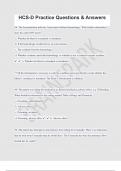HCS-D Practice Questions & Answers
48. The documentation indicates 'intracranial subdural hemorrhage'. What further information
does the coder NOT need?
a. Whether the bleed is extradural or intradural.
b. If the hemorrhage resulted in loss of consciousness.
c. The residuals from the hemorrhage
d. Whether a trauma caused the hemorrhage, or whether it was a cerebral vascular accident.
✔️✔️a. Whether the bleed is extradural or intradural.
**All the information is necessary to code the condition more specifically except whether the
bleed is extradural or intradural. The bleed is documented as subdural.
49. The patient was taking his medication as directed and had an adverse effect, e.g. GI bleeding.
What should be referenced in the coding manual Table of Drugs and Chemicals.
a. Poisoning, undetermined
b. Adverse effect
c. Poisoning, accident
d. Poisoning, adverse effect ✔️✔️b. Adverse effect
50. The patient has hemoptysis and epistaxis from taking his Coumadin. There is no indication
that he took more Coumadin than he should have. The Coumadin has been discontinued. How
should this be coded?
,a. R04.2, R04.0, D68.32, T45.515D
b. T45.511D, R04.2, R04.0
c. T45.515D, D68.32, R04.2, R04.0
d. D68.32, T45.515A ✔️✔️a. R04.2, R04.0, D68.32, T45.515D
**When a bleed results from an adverse effect of an anticoagulant, assign the codes for the bleed
and D68.32 and then the adverse effect of the medication.
51. Patient with several episodes of light headedness and vertigo. How would this be coded?
a. H81.3, R42
b. H81.49, R42
c. H81.0, R42
d. R42 ✔️✔️d. R42
52. The patient admitted to home health for speech therapy. The patient has dysphasia,
dysarthria, and slurred speech. How would this be coded?
a. R47.02, R47.1
b. R47.02, R47.1, R47.81
c. R47.82, R47.01, R47.1
d. R47.82, R47.01 ✔️✔️b. R47.02, R47.1, R47.81
**The signs and symptoms are coded until the physician has provided a definitive diagnosis.
, 53. A patient was admitted with a new diagnosis of colon cancer. He has fatigue related to his
cancer. He also has comorbid conditions of HTN, diastolic CHF, and diabetes. SN to teach
disease process. How would this be coded?
a. C18.9, I10, I50.30, E11.9
b. C18.9, R53.0, I10, I50.30, E11.8
c. C18.9, R53.32, I10, I50.30, E11.8
d. C19, R53.83, I10, I50.3, E11.9 ✔️✔️a. C18.9, I10, I50.30, E11.9
**Fatigue is a symptom indicative of several of the conditions and would not be coded
separately.
54. Patient admitted with weakness, loss of appetite and cachexia. How would this be coded?
a. R64, R63.0, R53.1
b. R63.4, R54
c. R63.0, R54
d. R53.83, R63.4 ✔️✔️a. R64, R63.0, R53.1
**The signs and symptoms are coded until the physician has provided a definitive diagnosis.
55. Non-infectious processes may result in systemic inflammatory response syndrome (SIRS).
Code acute biliary necrotic pancreatitis resulting in SIRS.
a. R65.20, K85.11
b. K85.11, R65.10




